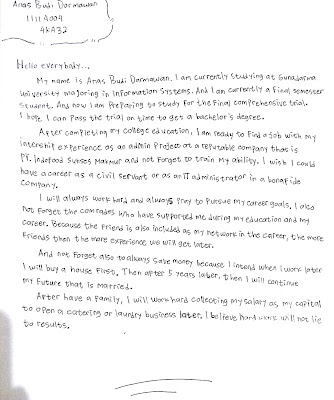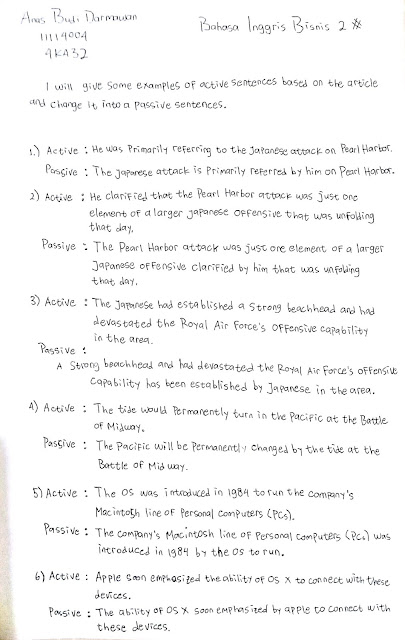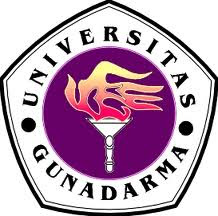I will give some examples of active sentences based on
the article and change it into a passive sentences.
*Active
sentences are indicated by underline
1.
The first article
Pearl Harbor in
Context
When U.S. Pres. Franklin D. Roosevelt declared that
December 7, 1941, would be “a date which will live in infamy,” he was
primarily referring to the Japanese attack on Pearl Harbor. However, later
in that same speech, he clarified that the Pearl Harbor attack was just one
element of a larger Japanese offensive that was unfolding that day. On
December 8 local time (the following locations are on the other side of the
International Date Line from the United States), several hours before the first
planes were sighted over Pearl Harbor, Japanese forces began an amphibious
invasion of Malaya. By that evening, the Japanese had established a strong
beachhead and had devastated the Royal Air Force’s offensive capability in the
area. Japanese bombers from Formosa struck U.S. airfields in the
Philippines, destroying more than half of the U.S. Army’s aircraft in the Far
East and wiping out the largest contingent of B-17 Flying Fortresses outside the
continental United States. Japanese bombers launched from the Marshall Islands
targeted the American garrison on Wake Island as the prelude to a land invasion
(the repulse of an initial amphibious assault on December 11 was the first
tactical defeat suffered by the Japanese navy in World War II). British air
power in Hong Kong was destroyed by a Japanese air raid, and Japanese land
forces invaded Thailand. Air raids on
Guam preceded an invasion that the island’s meager defensive units were ill
equipped to repel; American forces surrendered on December 10. In Shanghai the
gunboats USS Wake and HMS Peterel (U.S. and British flagged, respectively)
presented the only obstacles to Japanese occupation of the city’s International
Settlement. The Peterel was sunk by Japanese fire after a spirited but
ultimately futile defense, while the Wake’s skeleton crew was overwhelmed by a
Japanese boarding party, making that ship the only one in the U.S. Navy to be
captured intact during World War II. As Roosevelt summarized, “Japan has,
therefore, undertaken a surprise offensive extending throughout the Pacific
area.”
These successes were entirely in keeping with Japanese
Adm. Yamamoto Isoroku’s appraisal of the situation in the Pacific prior to
hostilities. “In the first six to twelve months of a war with the United States
and Great Britain, I will run wild and win victory upon victory. But then, if
the war continues after that, I have no expectation of success.” (This is
likely the inspiration for the apocryphal “sleeping giant” quote commonly
attributed to Yamamoto.) Indeed, almost exactly six months after Pearl Harbor, the
tide would permanently turn in the Pacific at the Battle of Midway. Yamamoto’s
sweeping, excessively complex battle plans, which had served him well in
December 1941, would prove to be his undoing at Midway. American naval pilots,
aided by decrypted Japanese communications and no small amount of luck,
destroyed Japan’s first-line carrier force and effectively deprived Japan of
the ability to prosecute an offensive war in the Pacific.
2. The second article
Mac OS
OPERATING SYSTEM
Mac OS, operating system (OS) developed by the
American computer company Apple Inc. The OS was introduced in 1984 to run
the company’s Macintosh line of personal computers (PCs). The Macintosh
heralded the era of graphical user interface (GUI) systems, and it inspired
Microsoft Corporation to develop its own GUI, the Windows OS.
Apple’s marketing for the introduction of the
Macintosh focused heavily on its operating system’s intuitive ease of use.
Unlike virtually all other contemporary PCs, the Mac OS (initially designated
simply System Software, with a version number appended) was graphically based.
Rather than typing commands and directory paths at text prompts, users moved a
mouse pointer to visually navigate the Finder—a series of virtual folders and
files, represented by icons. Most computer operating systems eventually adopted
the GUI model. In the 1980s Apple made an agreement allowing Microsoft to use
certain aspects of the Mac interface in early versions of Windows. However,
except for a brief period in the 1990s, Mac OS has never been licensed for use
with computers made by manufacturers other than Apple.
Later Mac OS releases introduced features such as
Internet file sharing, network browsing, and multiple user accounts. In 1996
Apple acquired rival NeXT Computers, which was founded by Steven Jobs after his
departure from Apple, and in 2001 the
company rolled out Mac OS X, a major redesign based on both the NextStep system
and Apple’s most recent OS release. OS X ran on a UNIX kernel (core software
code) and offered technical advances such as memory protection and preemptive
multitasking, along with a more versatile Finder, an elegant-looking interface
called Aqua, and a convenient graphical “Dock” bar for launching frequently
used applications. Updates to OS X added features such as automated backups and
a “Dashboard” manager for small, handy applications called widgets.
From 2007 Apple unveiled a number of mobile devices
that could access the Internet, including the iPhone smartphone and the iPad
tablet computer. Apple soon emphasized the ability of OS X to connect with
these devices. In 2011 Apple introduced iCloud, a cloud computing
service that allowed users to share data among all of their Apple devices, for
both OS X and the mobile operating system iOS. Apple added more features
allowing connectivity between devices to successive updates of OS X, iOS, and
later watchOS (the operating system for the Apple Watch smartwatch). These
features included the ability to receive phone calls (made to the iPhone) and
the means of quickly sharing data (such as photos and text) among devices.
Subscribe to:
Posts (Atom)













- Follow Us on Twitter!
- "Join Us on Facebook!
- RSS
Contact